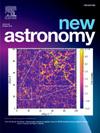First photometric investigation of V517 Cam combined with ground-based and TESS data
IF 2.1
4区 物理与天体物理
Q2 ASTRONOMY & ASTROPHYSICS
引用次数: 0
Abstract
The observations of eclipsing binary systems are of great importance in astrophysics, as they allow direct measurements of fundamental stellar parameters. By analysing high-quality space-based observations with ground-based photometric data, it becomes possible to detect these fundamental parameters with greater precision using multicolour photometry. Here, we report the first photometric analysis results of the V517 Cam eclipsing binary system by combining the Transiting Exoplanet Survey Satellite (TESS) light curve and new CCD observations in BVRI filters, obtained with a 60 cm robotic telescope (T60) at the TÜBİTAK National Observatory. By means of photometric analyses, the masses and radii of the primary and secondary stars were carefully determined to be , , and , , respectively. Furthermore, the distance to V517 Cam was calculated to be pc. The overall age of the system is estimated to be around Myr. At this age, the primary component stands near the onset of its main-sequence evolution, near the ZAMS, whereas the secondary component remains in the pre-main-sequence evolutionary phase. To better understand the evolutionary status and nature of V517 Cam, the mass ratio and temperature values, obtained with relatively low sensitivity by photometric measurements, need to be confirmed by spectral analysis.
首次结合地面和TESS数据对V517 Cam进行光度调查
对食双星系统的观测在天体物理学中非常重要,因为它们可以直接测量基本的恒星参数。通过分析高质量的天基观测和地面光度数据,可以使用多色光度法以更高的精度探测这些基本参数。在这里,我们报告了通过结合凌日系外行星测量卫星(TESS)的光曲线和BVRI滤光片上的新的CCD观测结果,在TÜBİTAK国家天文台使用60厘米机器人望远镜(T60)获得的V517 Cam食双星系统的首次光度分析结果。通过光度分析,确定了主星和副星的质量和半径分别为M1=1.47±0.06M⊙,M2=0.79±0.05M⊙,R1=1.43±0.03R⊙,R2=0.75±0.04R⊙。进而计算出到V517凸轮的距离为284±20 pc。据估计,该系统的总体年龄约为63±15 Myr。在这一年龄阶段,主要成分处于主层序演化的起始阶段,即ZAMS附近,而次要成分仍处于主层序前演化阶段。为了更好地了解V517 Cam的演化状态和性质,需要通过光谱分析对光度测量获得的相对较低灵敏度的质量比和温度值进行确认。
本文章由计算机程序翻译,如有差异,请以英文原文为准。
求助全文
约1分钟内获得全文
求助全文
来源期刊

New Astronomy
地学天文-天文与天体物理
CiteScore
4.00
自引率
10.00%
发文量
109
审稿时长
13.6 weeks
期刊介绍:
New Astronomy publishes articles in all fields of astronomy and astrophysics, with a particular focus on computational astronomy: mathematical and astronomy techniques and methodology, simulations, modelling and numerical results and computational techniques in instrumentation.
New Astronomy includes full length research articles and review articles. The journal covers solar, stellar, galactic and extragalactic astronomy and astrophysics. It reports on original research in all wavelength bands, ranging from radio to gamma-ray.
 求助内容:
求助内容: 应助结果提醒方式:
应助结果提醒方式:


